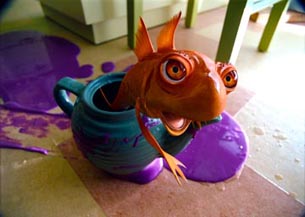|
|
What Went Wrong: The Cat in the HatBy Shalimar SahotaJanuary 12, 2012
The film was nominated for eight Razzie Awards, and ended up winning one - the Worst Excuse For An Actual Movie. Following his sole directorial effort, Welch didn’t work on a film again till 2008, back as a production designer on Space Chimps. He has most recently worked with Barry Sonnenfeld on Men in Black III. Because of The Cat in the Hat, there will be no more live action Dr. Seuss movies in the future. Audrey Geisel, widow of Dr. Seuss, and president of Dr. Seuss Enterprises, was not impressed with the film and did not approve of Myers in the role of The Cat. She refuses to allow any of Dr. Seuss characters to be portrayed in live action again and has subsequently kept a watchful eye on the latest adaptations, serving as executive producer on Horton Hears a Who! and The Lorax. There are some clever moments of blatant cross promotion during the final act, as The Cat advertises Universal Studios and mentions the "importance" of including “an up tempo pop tune for the soundtrack.” However, these moments also highlight what a beloved children’s story has gone through for its big screen adaptation. It’s more about getting the audience to part with their cash through one avenue or another rather than preserving what people loved about the original story. At the time, it was reported by the Washington Post that The Cat in the Hat was “one of the largest business backed films in Hollywood,” with 75 companies producing related products to tie-in with the film. Coming across as the kind of insensitivity that’s been tailor made towards the lowest common denominator, The Cat in the Hat distorts the Dr. Seuss book, as well as the character of The Cat. It doesn’t seem to make any sense that someone out there thought the addition of crude jokes was the right way to honor Dr. Seuss. Still, if that’s what Welch and Universal wanted, then maybe they should have just gone all the way and turned it into an R-rated comedy re-titled Fear of a Black Cat.
[ View other columns by Shalimar Sahota ]
[ View other What Went Wrong columns ]
[ Email this column ]
|

|
|
|

|
Friday, November 1, 2024
© 2024 Box Office Prophets, a division of One Of Us, Inc.


